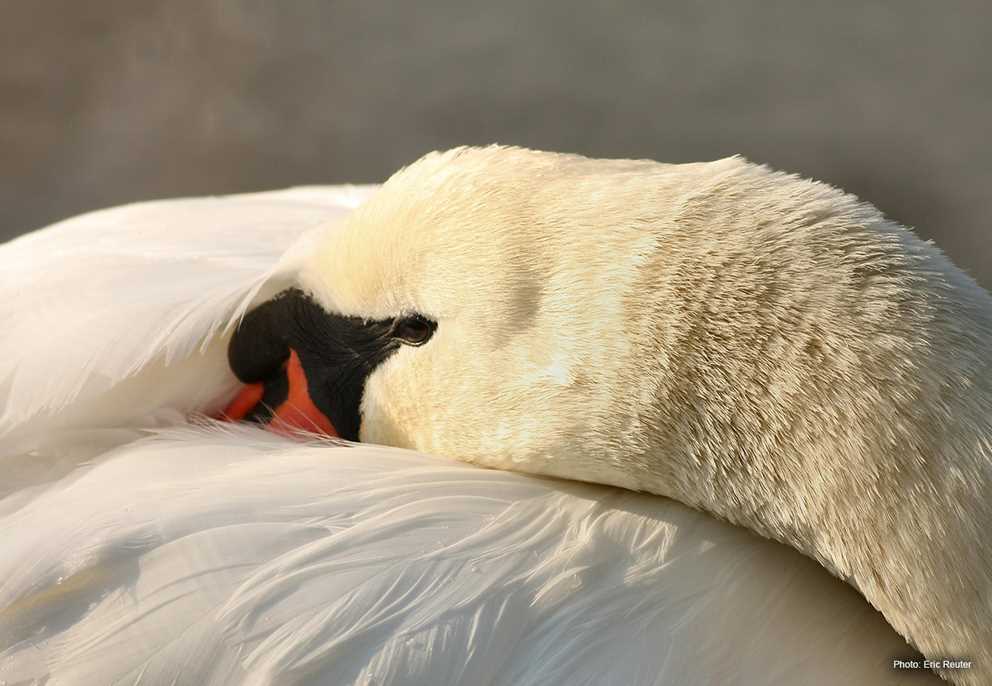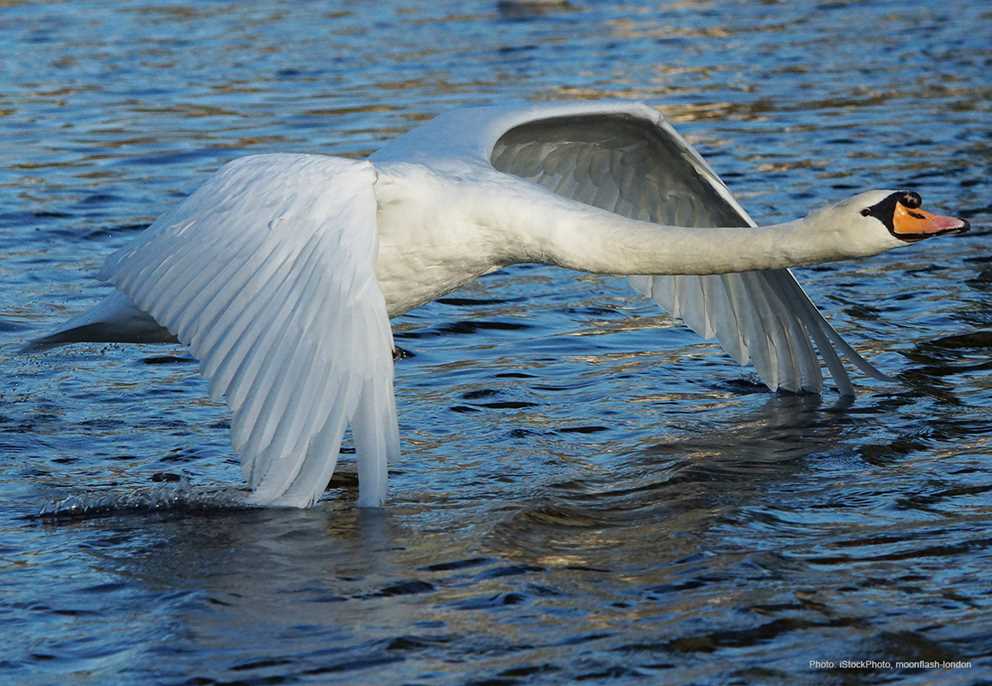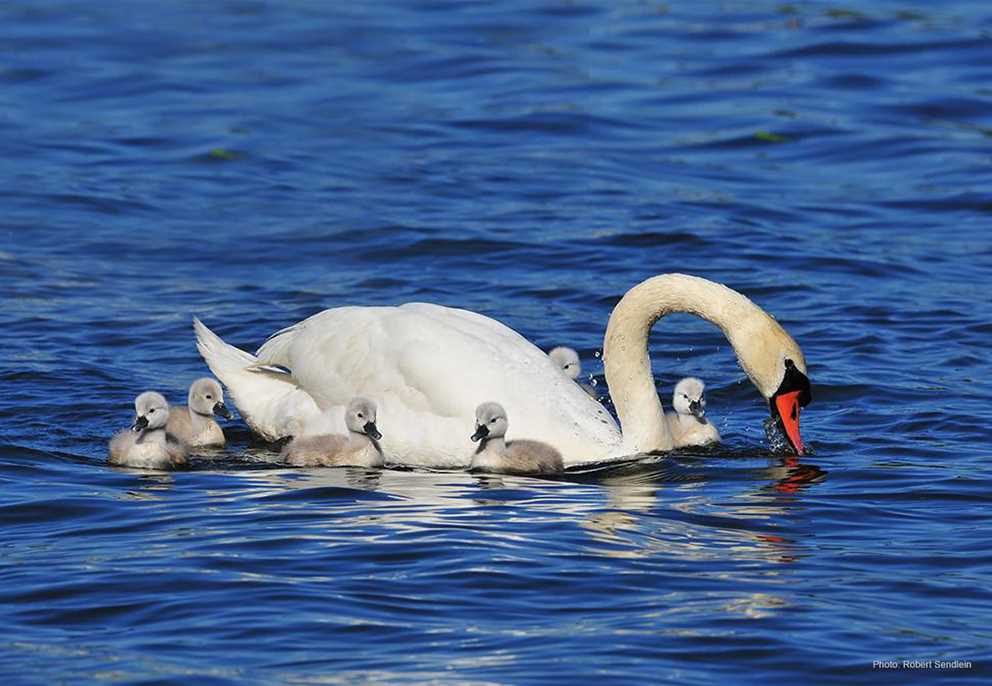Overview
The Mute Swan is native to Eurasia and was introduced to North America in the early 1900s, where it has now become an invasive species. They are large, unmistakable white swans, with an orange bill having a black knob at the base that distinguishes them from native Trumpeter and Tundra Swans. The feet are black.
Invasive populations occur in the Chesapeake Bay area, and in coastal areas of several mid-Atlantic states from Massachusetts to South Carolina. They are also established in several Great Lakes states including Wisconsin, Illinois, Michigan, Ohio, and in Ontario along Lake Erie and Lake Ontario. In the west, Mute Swans have established populations in the Puget Sound region of Washington and Vancouver Island, British Columbia, and in the San Francisco Bay Area of California.
Mute swans use a variety of wetland habitats that contain abundant aquatic vegetation – placing them in direct competition for habitat and food resources with many species of waterfowl native to North America. They are nonmigratory but may move to larger lakes and bays during winter.
Description
Key Identification Features
- Males are usually larger than females.
- The plumage of adult Mute Swans is white. The bill is orange with a notable black knob at the base, with black extending to the front of the eye. The feet are black.
- Immatures are grayish to brownish overall, with and pinkish bill with a less pronounced knob, and grayish feet.
Male/Female Average Length and Weight
- Mass: Males 20.3–34.6 lbs.; Females 13.4–26.9 lbs.
- Wing Length: Males 22.8–24.5 in.; Females 12.0–23.2 in.
Male and Female Identification
- Alternate (Breeding) Plumage and Basic Plumage: Both adult plumages of both sexes are identical. White, with orange bills (the only swan in North America with an orange bill) having a large black knob at the base. The black at base of bill extends to just anterior of eye. Feet are black.
In-flight Identification
- Males and females are both white, and their wings make a whistling or humming sound.
Vocalizations
- They are often silent, but they are not mute, with the species having 8– 10 different calls used variously to greet mates, respond to threats, lost or location calls, and others.
Similar Species
- Adults are unique and unlikely to be confused with any other species of swan in North America. The only swan in North America with an orange (adult) or pinkish (immature) bill, with a pronounced knob.
Habitat Preferences
- Mute Swans are typically found in freshwater or brackish wetlands, ponds, or lakes, usually with substantial emergent or floating vegetation upon which they feed. They are nonmigratory, though they may move to large water bodies in winter.
Foraging Habits and Diet
- Mute Swans are vegetarian with a diet often of >95% submerged plant material. Vegetation consumed includes tubers, roots, stems, and leaves of various emergent and aquatic plants. They tend to uproot plants, and can reduce or eliminate species and biomass, placing them in direct competition with many other species of native North American waterfowl.
Breeding Habits
- Monogamy: Mute Swans maintain monogamous, lifelong pair bonds.
- Nest Locations: Nesting occurs as early February depending on ice conditions but is usually from March to May in North America. The nest is a large mound of plant material usually on top of emergent vegetation or islands.
- Clutch Size: 5 To 8 eggs. The eggs are blue-green when laid and become white to olive brown (stained) as incubation progresses. Eggs are sub-elliptical average 4.4 by 3.0 in. The incubation period is 36 days, with females performing incubation, and males providing nest defense.
Migration & Distribution
- Mute Swans are nonmigratory but may move to larger water bodies in winter to avoid ice cover. Northernmost populations may make short migrations to areas with open water.

Conservation Status
- IUCN Status: Least Concern
- Population Status: The global population is stable to increasing throughout their range, but the species is not subject to large-scale surveys. There are an estimated 22,000– 25,000 Mute Swans in North America, with populations stable to increasing.
Harvest Information
- In the United States, the Migratory Bird Treaty Act does not protect Mute Swans, but there is no hunting season. Mute Swans are considered a protected species in Canada under the Migratory Bird Treaty. The USFWS published an Atlantic Flyway Mute Swan Plan aimed at reducing the population to fewer than 3,000 birds by permitting hunting and encouraging states to euthanize adults and lethally treat eggs. Subsequently, the estimate AF population was reduced from 13,000 to 6,000. Efforts continue to reduce numbers to the goal of less than 3,000. The State of Michigan has a goal to eliminate Mute Swans from Michigan, and to date has reduced the population from 17,500 to 8,000 as of 2019. Population reduction/elimination is necessary because Mute Swans are very destructive to native emergent vegetation and reduce food availability for many species of native waterfowl species, other birds, and other wildlife and fish.




